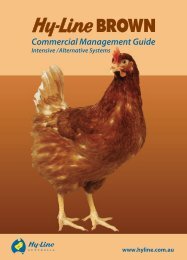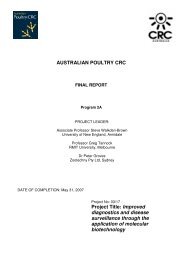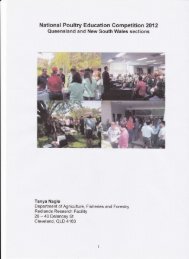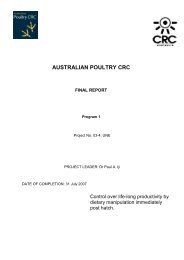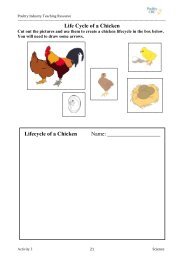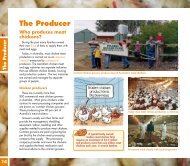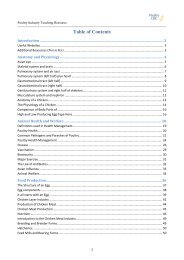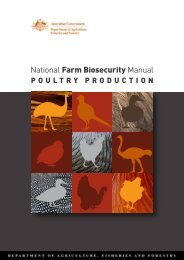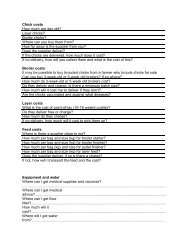AUSTRALIAN POULTRY CRC - Poultry Hub
AUSTRALIAN POULTRY CRC - Poultry Hub
AUSTRALIAN POULTRY CRC - Poultry Hub
- No tags were found...
Create successful ePaper yourself
Turn your PDF publications into a flip-book with our unique Google optimized e-Paper software.
IntroductionIndustry ProfileFree-range is the poultry housing system most actively supported by welfare groups. Birds in freerangesystems are housed in sheds and have access to an outdoor range (Model Code of Practice forthe Welfare of Animals: Domestic <strong>Poultry</strong> 4 th Ed). This is a traditional system for egg productionwhich still today provides a vision of „farm fresh eggs‟ associated with it, where hens can wander atwill over green pastures with no environmental restrictions (Kilgour and Dalton, 1984).Irrespective of a likely gradual increase in demand for free range eggs to eventually become asignificant part of the Australian egg market, free range is nevertheless an important sector as it allowsconsumers the opportunity to exercise their buying preferences; this provision of adequate choice islikely to be an important factor in managing the industry welfare debate. Currently there are 1.69million free range hens in Australia (11% of total laying hens in Australia) with an estimated grocerymarket share of 14.5%. Free range eggs are worth 23% of the value of the Australian egg industry,which is more than $71 million a year.Margins are slim due to higher production costs, and mortality in free-range systems can be high (21%Kjaer and Sorensen, 2002, 32% Sommer and Vasicek, 2000, and 15-20% Kristensen, 1998) which isunacceptable to the producer, industry and public where negative impacts can be monetary, ethicaland/or environmental. Egg production is lower and feed intake is higher under current free rangeconditions than in cage systems for a number of reasons, including different environmental challenges,energy requirements, strains and husbandry. Large-scale free range production may also beenvironmentally unfriendly.There is limited scientifically sound information on causes of mortality in free-range flocks inAustralia.Causes of mortalityFeather pecking and/or cannibalismFeather pecking is one of the most serious behavioural problems in commercial laying hens,particularly in loose-housing systems where many hens can be affected by only a few hens that engagein feather pecking (McAdie and Keeling, 2000, and Pötzsch et al., 2001). There are four types of birdto-birdpecking. 1. Aggressive pecking is directed by dominant birds at subordinates, and its objectiveis to establish and maintain dominance and can lead to severe injury or death if the recipient cannotescape. 2. Feather pecking without removal of feathers causes little or no damage and is sometimesdirected at particles of litter or food lying on the plumage or around the beak. 3. Feather pullingleading to feather loss is much more forceful pecking. The feather is grasped and firmly pulled, andthis may cause the recipient to squawk and withdraw. Hens can become almost completely denuded asa result of this pecking (McAdie and Keeling, 2000). 4. Forceful pecking is often persistently directedat exposed skin and this can lead to haemorrhage. The removal of feathers by feather pecking canresult in bleeding from the skin and follicles (especially with immature feathers), which maypredispose hens to cannibalism (McAdie and Keeling, 2000). In the flock, feather pecking may resultin increased mortality, decreased egg production and increased food consumption (Appleby andHughes, 1991, Bilčík and Keeling, 1999 and Pötzsch et al., 2001). <strong>Hub</strong>er-Eicher and Audige (1999)investigated the potential risk factors for the occurrence of feather pecking in laying hens raised undercommercial conditions on a Swiss farm with more than 500 rearing places. The factors examinedconsidered the most important as being likely to influence feather pecking included stocking density,light intensity, intensity of care, access to elevated perches, access to a roofed and littered outdoorarea, time of access to feeding facilities of the housing system, stocking density in the restricted area atthe beginning of the rearing period and air quality. The study identified two risk factors and concludedthat chicks should be reared at low density and with access to elevated perches.1



